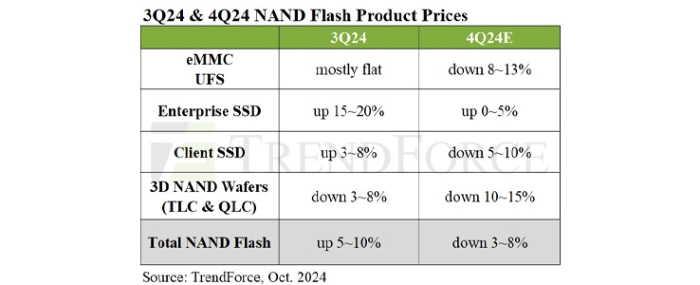
Increased supply and weakened demand to lower NAND Flash prices
TrendForce’s latest findings reveal that NAND Flash products have been impacted by weaker-than-expected seasonal demand in the second half of 2024, leading to a decline in wafer contract prices in Q3.
This downward trend is projected to deepen, with prices expected to drop by more than 10% in Q4.
Enterprise SSDs are the only segment likely to see modest price growth — supported by stable order momentum — with contract prices forecast to rise by 0–5% in Q4. However, PC SSDs and UFS will see more cautious procurement strategies from buyers, as weaker-than-expected sales of end products drive buyers to adopt a conservative approach. As a result, TrendForce projects overall NAND Flash contract prices will decline by 3–8% in Q4.
Client SSD prices expected to decline 5-10%
From a demand perspective, inflation and limited practical use cases for AI have hindered any significant upgrade cycles despite manufacturers actively introducing AI-powered PCs. Meanwhile, on the supply side, several major manufacturers returned to full capacity utilization in Q3, while other suppliers increased production through process upgrades, resulting in a modest rise in overall capacity. However, stable server-side demand alone is insufficient to support price increases, given the sluggish consumer market.
The widening gap between spot market prices, channel prices, and OEM contract prices has further restricted suppliers’ ability to raise prices. Consequently, TrendForce forecasts that PC client SSD contract prices will decline by 5–10% in Q4.
Growth momentum of enterprise SSD slows down and prices set to rise 0-5%
Q4 server OEM orders have experienced a noticeable decline due to delays in AI server deployments by some enterprise customers. In addition, the peak purchasing period for CSPs has passed, resulting in lower overall procurement volumes compared to Q3.
Meanwhile, smartphone and notebook manufacturers have adopted inventory reduction strategies, leading to more conservative NAND Flash orders. However, ongoing production increases by suppliers have led to oversupply.
TrendForce notes that enterprise SSDs remain more profitable and in higher demand compared to other NAND Flash products, prompting suppliers to aggressively pursue orders and increase bit shipments. This strategy is expected to constrain price growth. Thus, enterprise SSD contract prices in Q4 are projected to rise only marginally by 0–5%.
eMMC prices expected to drop 8-13% amid buyer leverage
The smartphone market showed no signs of recovery in Q3, with many manufacturers depleting eMMC inventory and resisting price increases, resulting in limited transaction volume. While new models—such as the iPhone 16 series, Huawei’s foldable phone, and several Chinese brand launches—appear to bring fresh momentum to the eMMC market, buyers are likely to adopt more conservative stocking strategies to avoid over-inventory risks.
TrendForce reports that after prolonged price standoffs between buyers and suppliers in Q3, increased supplier inventory and ample stock in both module and spot markets have tipped the balance in favor of buyers. As a result, Q4 eMMC contract prices are expected to decline by 8–13%.
UFS prices to decline 8-13% as demand stagnates
UFS, mainly used in premium and flagship smartphones, faces a similar market to eMMC. Sluggish economic growth has extended the average smartphone replacement cycle from under two years to three, and the market still lacks a breakthrough application to drive significant upgrades.
With both manufacturers and module makers competing for market share in a soft demand environment, suppliers are likely to offer price concessions to avoid overstocking and meet sales targets. Consequently, TrendForce projects UFS contract prices will also drop 8–13% in Q4.
NAND Flash wafer prices expected to drop 10-15%
Retail demand for client SSDs, memory cards, and USB drives has remained sluggish since the beginning of 2024. Seasonal back-to-school and holiday sales in Europe and the US have failed to boost consumer interest, while China’s economic slowdown is expected to weaken demand during this year’s Double 11 Shopping Festival. These factors are likely to further exacerbate the decline in NAND Flash wafer demand in Q4.
TrendForce points out that with module makers holding excessive inventory and some suppliers engaging in price-cutting strategies to stay competitive, NAND Flash wafer contract prices are set to decline significantly. TrendForce forecasts a 10–15% drop in Q4, with the possibility of even steeper reductions if market conditions deteriorate further.
For more information visit TrendForce.



